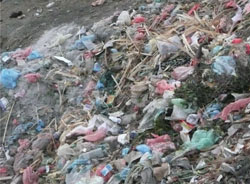Liquid waste
Liquid waste includes human waste, runoff (storm water or flood water), sullage, industrial wastewater and other forms of wastewater from different sources. Human waste is mainly composed of faeces and urine, which together are known as excreta. All human body waste is classed as liquid waste. The mixture of human waste with wastewater is known as sewage and also sometimes known as blackwater. Runoff is simply rainwater that collects on the ground and runs off into channels, ditches and rivers. Sullage, also known as greywater, is water that has been used for washing in bathrooms and kitchens; it does not include human waste.
Human waste is biodegradable and when contained in a waste containment facility (for example, a pit latrine or septic tank) it undergoes a biological digestion process by which microorganisms, particularly bacteria, decompose the organic matter. The decomposing bacteria found in pit latrines and septic tanks do not require oxygen and are called anaerobic bacteria. The digestion process may take from several days to a few months, depending on the atmospheric temperature and other local conditions, before it is completely decomposed or degraded. The digested waste matter is called sludge.
Biodegradable and non-biodegradable wastes
Biodegradable wastes are those that can be broken down (decomposed) into their constituent elements by bacteria and other microorganisms. The term can be applied to both liquid and solid waste. Human and animal wastes, food waste, paper, and agricultural wastes are all biodegradable. This natural biological decomposition process ensures that, under the right conditions, these wastes do not accumulate in the environment.
Many plastics are not biodegradable and these create environmental problems because they remain unchanged for many years. The bacteria responsible for biodegradation may be aerobic, meaning they require oxygen, or anaerobic, meaning they do not need oxygen to survive. Decomposition of biodegradable wastes by anaerobic bacteria is sometimes called digestion.

Do you think human waste is a danger to health?
Yes it is. Human waste must be considered as potentially infectious matter because it may contain pathogenic organisms.
Although human waste is a potential source of disease, the amount of human faeces disposed of indiscriminately in open fields and under bushes, mostly in rural settings, is a major problem. In rural areas, a large proportion of households do not have pit latrines and although this situation is changing, open defecation continues to be widely practised. Open defecation can spread disease, contaminate the soil and pollute drinking water sources, as discussed in previous study sessions. To avert these risks, households and communities should work towards community goals to be ‘open defecation free'. This can be achieved through the building, and consistent use of, onsite communal or human waste disposal facilities. Onsite facilities are, for example, pit latrines built in the compound of households; communal or public facilities are latrines built in streets or in market places. These public latrines are also referred to as municipal facilities.